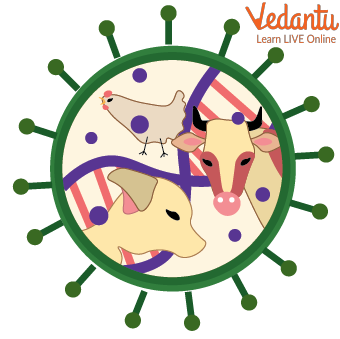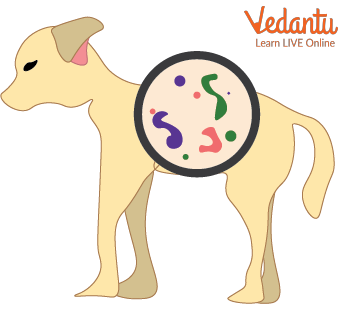




Introduction to Animals Diseases
Have you ever thought that there are some similarities between humans and animals? One of the similarities is that animals other than humans can also suffer from different types of animal diseases, the same as humans. People are worried mainly about the diseases that directly affect animals that are used for food, the diseases that affect pets, and the diseases that can be spread from animals to people.
Similarly to human diseases, animal diseases are divided into two groups as infectious animal diseases and noninfectious animal diseases. The doctors who treat the animal for various animal diseases caused by bacteria or any other disease or illness are known as veterinarians. These veterinarians can treat many diseases.
Let us read about these animal diseases in detail !
Types of Animal Diseases
In this article, we will discuss two types of animal diseases. First is Infectious diseases and another is Non-infectious diseases.
Infectious Diseases
The diseases that spread from one animal to another are called infectious diseases. These diseases are caused by particles known as viruses and tiny living things such as bacteria, protozoans, fungi, and worms.
Rabies is one of the most dangerous animal diseases. Rabies directly attacks the brain. A virus in the saliva of animals with bacteria causing rabies can also cause the disease. Rabies often spreads through animal bites. People can also get rabies disease. Luckily, there is a vaccine that can protect people as well as animals from rabies.
The other virus causes Newcastle disease, which is a disease that affects chickens, turkeys, as well as pet birds. The symptoms of Newcastle disease are the same as that of influenza or flu. People can also be affected by this disease from sick birds.
Tuberculosis is an animal disease caused by bacteria and mainly affects cattle. The disease is harmful to the lungs. To people, tuberculosis can spread through the milk of cows.

Animal Diseases
Non-Infectious Diseases
The diseases that cannot be spread from one animal to another are called non-infectious diseases. The non-infectious diseases in animals are much similar to that of the non-infectious diseases in humans.
Non-infectious Diseases Examples:
A disease like cancer can affect many older dogs, cats, and other animals. Pets and many other wild animals can also suffer from arteriosclerosis. This arteriosclerosis is a disease in which the blood vessels become blocked. A cataract is a disease in which many animals over their eyes can develop cloudy growths.

Animal disease due to bacteria
Animal Diseases Caused by Bacteria
List of Animal Diseases and Their Causes
Below mentioned are the animal diseases caused by bacteria:
Anthrax
Black quarter(commonly known as black leg disease)
Foot and mouth disease
Rabies (also called Mad dog disease)
Bluetongue
Pox
Brucellosis of sheep
Tetanus
Below mentioned are the animal diseases caused by virus:
African horse sickness
African swine fever (ASF)
Bluetongue
Equine infectious anaemia
Summary
Animal diseases can be caused by bacteria, viruses, parasites, fungi, nutritional deficiencies, chemical poisons, and many unknown causes. The doctors who treat animals for various animal diseases are known as veterinarians. Infectious diseases are diseases that spread from one animal to another. Non-infectious diseases are diseases that cannot be spread from one animal to another. One of the most dangerous animal diseases is rabies. This spreads through animal bites. Cancer is an example of a non-infectious disease in animals.
FAQs on Animals Diseases
1. What are animal diseases?
An animal disease is any condition that harms an animal's normal body functions. It can be caused by infections, poor diet, or inherited problems. A sick animal might look tired, eat less, or behave differently than usual.
2. How are animal diseases classified?
Animal diseases are mainly classified into two types:
- Infectious diseases: These are caused by germs like bacteria, viruses, or fungi and can spread from one animal to another.
- Non-infectious diseases: These are not caused by germs and cannot spread. They can result from issues like a poor diet, injuries, or genetic problems.
3. What are the main causes of infectious diseases in animals?
The primary causes of infectious diseases in animals are tiny living organisms called pathogens. The main types are:
- Bacteria: Single-celled organisms that can cause illnesses like Anthrax.
- Viruses: Microscopic agents that cause diseases such as Rabies and Foot-and-mouth disease.
- Fungi: Organisms that can cause skin infections like Ringworm.
- Parasites: Creatures that live on or inside another animal, like ticks and worms.
4. What are some examples of non-infectious diseases in animals?
Non-infectious diseases do not spread between animals. Some common examples include:
- Nutritional deficiencies: Sickness caused by a lack of essential vitamins or minerals in their food.
- Allergies: Reactions to certain foods or substances in the environment.
- Injuries: Physical harm like broken bones or cuts.
- Poisoning: Illness from swallowing toxic substances.
5. Can you give five common examples of infectious animal diseases?
Yes, here are five common infectious diseases found in animals:
- Rabies: A deadly viral disease affecting the nervous system, often spread by bites from infected animals.
- Foot-and-Mouth Disease: A highly contagious viral illness in cattle and pigs, causing sores on the mouth and feet.
- Anthrax: A serious bacterial disease that can affect farm animals like cattle and sheep.
- Avian Influenza (Bird Flu): A viral disease that primarily affects birds, especially poultry like chickens.
- Ringworm: A common fungal infection that causes itchy, circular rashes on the skin.
6. Why is it important to prevent diseases in farm animals?
Preventing diseases in farm animals is crucial for several reasons. Healthy animals provide safe and healthy products like milk, eggs, and meat. Sick animals can suffer and may not produce food, which affects a farmer's livelihood. Furthermore, some animal diseases can spread to humans, so keeping animals healthy helps protect our community too.
7. How can we tell if an animal is sick?
You can often tell an animal is sick by observing changes in its behaviour and appearance. Common signs include:
- Loss of appetite or not drinking water.
- Appearing tired, weak, or isolated from others.
- Changes in their coat, such as dullness or hair loss.
- Difficulty walking, standing, or breathing.
- Unusual sounds like coughing or groaning.
8. Can diseases spread from animals to humans? What is this called?
Yes, some infectious diseases can be transmitted from animals to humans. These are called zoonotic diseases (or zoonoses). Rabies is a well-known example. It is important to be careful around sick animals and maintain good hygiene, like washing hands after touching them, to prevent the spread of such diseases.









